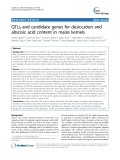
TNU Journal of Science and Technology
230(01): 91 - 97
http://jst.tnu.edu.vn 91 Email: jst@tnu.edu.vn
EVALUATION OF THE ABILITY OF IAA BIOSYNTHESIS AND THE EFFECT
TO GERMINATION ON MAIZE KERNELS OF HALOTOLERANT
PHOSPHATE-SOLUBILIZING BACTERIA Pantoea sp. TTB4.1
Bui Thi Hoai Thanh, Nguyen Ngoc Thien Huong, Le Quoc Viet, Tran Van Be Nam, Tran Thi Giang*
Institute of Food and Biotechnology - Can Tho University
ARTICLE INFO
ABSTRACT
Received:
08/7/2024
Plant Growth-Promoting Bacteria (PGPR) are a group of bacteria
beneficial to crops, among which Phosphate-Solubilizing Bacteria
(PSB) are of interest due to their ability to support plant resistance to
salt stress and produce plant growth-promoting substances. This study
aims to investigate the synthesis capability of the plant growth-
promoting substance indole acetic acid (IAA) by the salt-tolerant
phosphate-solubilizing Pantoea sp. TTB4.1 strain and its effect on the
germination ability of corn seeds immersed in bacterial suspension.
The research findings indicate that over a 10-day cultivation period,
the Pantoea sp. TTB4.1 strain was able to synthesize IAA in
quantities ranging from 1.163 to 3.916 µg/mL, with the highest IAA
content observed on day 4. Concurrently, this study also evaluates the
impact of the salt-tolerant phosphate-solubilizing Pantoea sp. TTB4.1
strain on the germination ability of corn seeds through experiments
involving immersion in bacterial suspension for 30, 60, 90 minutes.
The results showed that root length, shoot length, number of roots,
and germination rate of the corn seeds were all higher compared to the
control experiment (without bacterial immersion).
Revised:
16/10/2024
Published:
17/10/2024
KEYWORDS
Germination
Growth stimulation
Indole acetic acid (IAA)
Maize kernels
Pantoea
ĐÁNH GIÁ KHẢ NĂNG SINH TỔNG HỢP IAA VÀ HIỆU QUẢ
ĐẾN SỰ NẨY MẦM HẠT NGÔ CỦA VI KHUẨN HÒA TAN PHOSPHATE
CHỊU MẶN Pantoea sp. TTB4.1
Bùi Thị Hoài Thanh, Nguyễn Ngọc Thiên Hương, Lê Quốc Việt, Trần Văn Bé Năm, Trần Thị Giang*
Viện Công nghệ Sinh học và Thực phẩm - Trường Đại học Cần Thơ
THÔNG TIN BÀI BÁO
TÓM TẮT
Ngày nhận bài:
08/7/2024
Vi khuẩn thúc đẩy sinh trưởng thực vật (PGPR) là nhóm vi khuẩn có
lợi cho cây trồng trong đó nhóm vi khuẩn hòa tan lân (PSB) được
quan tâm bởi khả năng hỗ trợ cây trồng chống chịu với stress mặn và
sản sinh chất kích thích sinh trưởng thực vật. Nghiên cứu này nhằm
khảo sát khả năng tổng hợp chất kích thích sinh trưởng thực vật
indole acetic acid (IAA) của chủng vi khuẩn hòa tan lân chịu mặn
Pantoea sp. TTB4.1 và khảo sát ảnh hưởng đến khả năng nảy mầm
của hạt ngô khi ngâm trong dịch huyền phù vi khuẩn. Từ kết quả
nghiên cứu, trong 10 ngày nuôi cấy chủng vi khuẩn Pantoea sp.
TTB4.1 có khả năng tổng hợp IAA với hàm lượng từ 1,163 - 3,916
µg/mL, trong đó hàm lượng IAA đạt cao nhất vào ngày 4. Đồng thời,
nghiên cứu này cũng đánh giá tác động của chủng vi khuẩn hòa tan
lân chịu mặn Pantoea sp. TTB4.1 đến khả năng nảy mầm của hạt ngô
bằng các nghiệm thức ngâm trong dịch huyền phù vi khuẩn trong 30,
60, 90 phút và các kết quả chiều dài rễ, chiều dài mầm, số rễ và tỷ lệ
nảy mầm của hạt ngô ghi nhận đều cao hơn khi so sánh với nghiệm
thức đối chứng (không ngâm vi khuẩn).
Ngày hoàn thiện:
16/10/2024
Ngày đăng:
17/10/2024
TỪ KHÓA
Hạt ngô
Indole acetic acid (IAA)
Kích thích tăng trưởng
Sự nảy mầm
Vi khuẩn Pantoea
DOI: https://doi.org/10.34238/tnu-jst.10727
* Corresponding author. Email: ttgiang@ctu.edu.vn







